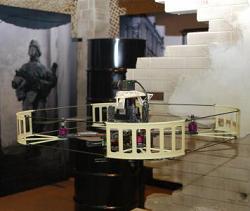Dec 6 2010
The 27th Annual Army Science Conference, which was held in Orlando between November 29 and December 2, featured a flying robotic platform dubbed ‘Pelican’. This robot was developed by the University of Pennsylvania. It is a self-guided robot, whose navigation cannot be interrupted by obstacles found in its course.
This project comes under the Micro Autonomous Systems and Technology Collaborative Technology Alliance (MAST CTA) of the Army Research Laboratory (ARL), which is the corporate lab of the US Army.
 Flying Pelican Robot
Flying Pelican Robot
Penn's Nathan Michael, one of the project members, has stated that their project is aimed at making the robot to navigate by means of a map, without human involvement. He added that the weight of the robotic platforms is below 3 pounds and is highly efficient and compact.
The Pelican robot features a laser camera, superior sensing technologies, a low-weight computer to analyze whatever viewed and sensed by the robot. The robot can fly both inside and outside a room, but demands highly intricate computing.
Michael has mentioned that the robotic platform ascertains its course by considering its surroundings, flying parameters and also requires battery power. The researchers are working on reducing the size of the pelican.
This strategic alliance of Penn with CTA for developing the automation research is actually headed by BAE Systems, serving as a collaborator between ARL, eight sub-awardees, 10 member organizations and three conversion partners.
Their ultimate focus is to build automated, multi-performing group of active, mobile micro-systems to help small unit operations by updating situational awareness in tough landscapes.